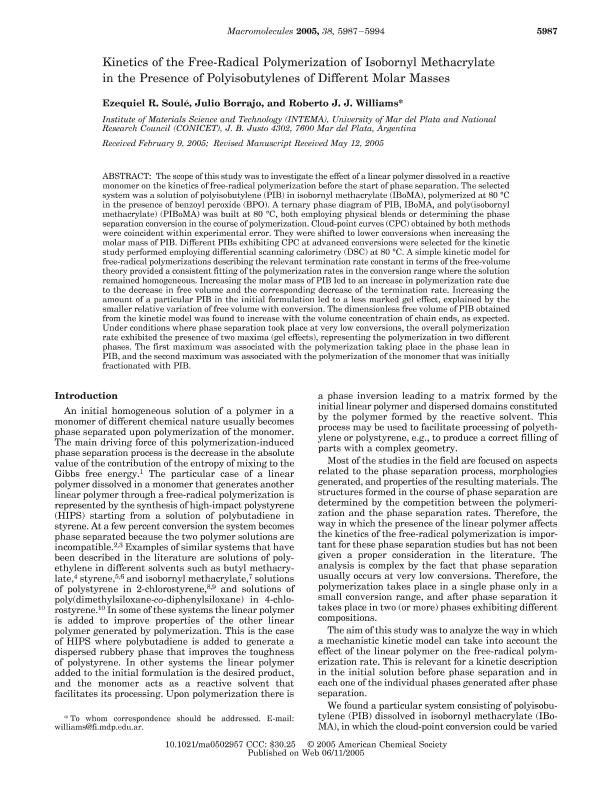Mostrar el registro sencillo del ítem
dc.contributor.author
Soulé, Ezequiel Rodolfo

dc.contributor.author
Borrajo Fernandez, Julio

dc.contributor.author
Williams, Roberto Juan Jose

dc.date.available
2017-11-15T19:49:49Z
dc.date.issued
2005-06-11
dc.identifier.citation
Soulé, Ezequiel Rodolfo; Borrajo Fernandez, Julio; Williams, Roberto Juan Jose; Kinetics of the free-radical polymerization of isobornyl methacrylate in the presence of polyisobutylenes of different molar masses; American Chemical Society; Macromolecules; 38; 14; 11-6-2005; 5987-5994
dc.identifier.issn
0024-9297
dc.identifier.uri
http://hdl.handle.net/11336/28280
dc.description.abstract
The scope of this study was to investigate the effect of a linear polymer dissolved in a reactive monomer on the kinetics of free-radical polymerization before the start of phase separation. The selected system was a solution of polyisobutylene (PIB) in isobornyl methacrylate (IBoMA), polymerized at 80 °C in the presence of benzoyl peroxide (BPO). A ternary phase diagram of PIB, IBoMA, and poly(isobornyl methacrylate) (PIBoMA) was built at 80 °C, both employing physical blends or determining the phase separation conversion in the course of polymerization. Cloud-point curves (CPC) obtained by both methods were coincident within experimental error. They were shifted to lower conversions when increasing the molar mass of PIB. Different PIBs exhibiting CPC at advanced conversions were selected for the kinetic study performed employing differential scanning calorimetry (DSC) at 80 °C. A simple kinetic model for free-radical polymerizations describing the relevant termination rate constant in terms of the free-volume theory provided a consistent fitting of the polymerization rates in the conversion range where the solution remained homogeneous. Increasing the molar mass of PIB led to an increase in polymerization rate due to the decrease in free volume and the corresponding decrease of the termination rate. Increasing the amount of a particular PIB in the initial formulation led to a less marked gel effect, explained by the smaller relative variation of free volume with conversion. The dimensionless free volume of PIB obtained from the kinetic model was found to increase with the volume concentration of chain ends, as expected. Under conditions where phase separation took place at very low conversions, the overall polymerization rate exhibited the presence of two maxima (gel effects), representing the polymerization in two different phases. The first maximum was associated with the polymerization taking place in the phase lean in PIB, and the second maximum was associated with the polymerization of the monomer that was initially fractionated with PIB.
dc.format
application/pdf
dc.language.iso
eng
dc.publisher
American Chemical Society

dc.rights
info:eu-repo/semantics/openAccess
dc.rights.uri
https://creativecommons.org/licenses/by-nc-sa/2.5/ar/
dc.subject
Free-Radical Polymerization
dc.subject
Solution Polymerization
dc.subject
Free Volume
dc.subject.classification
Otras Ciencias Químicas

dc.subject.classification
Ciencias Químicas

dc.subject.classification
CIENCIAS NATURALES Y EXACTAS

dc.subject.classification
Físico-Química, Ciencia de los Polímeros, Electroquímica

dc.subject.classification
Ciencias Químicas

dc.subject.classification
CIENCIAS NATURALES Y EXACTAS

dc.title
Kinetics of the free-radical polymerization of isobornyl methacrylate in the presence of polyisobutylenes of different molar masses
dc.type
info:eu-repo/semantics/article
dc.type
info:ar-repo/semantics/artículo
dc.type
info:eu-repo/semantics/publishedVersion
dc.date.updated
2017-11-03T19:57:22Z
dc.journal.volume
38
dc.journal.number
14
dc.journal.pagination
5987-5994
dc.journal.pais
Estados Unidos

dc.journal.ciudad
Washington
dc.description.fil
Fil: Soulé, Ezequiel Rodolfo. Consejo Nacional de Investigaciones Científicas y Técnicas. Centro Científico Tecnológico Conicet - Mar del Plata. Instituto de Investigaciones en Ciencia y Tecnología de Materiales. Universidad Nacional de Mar del Plata. Facultad de Ingeniería. Instituto de Investigaciones en Ciencia y Tecnología de Materiales; Argentina
dc.description.fil
Fil: Borrajo Fernandez, Julio. Consejo Nacional de Investigaciones Científicas y Técnicas. Centro Científico Tecnológico Conicet - Mar del Plata. Instituto de Investigaciones en Ciencia y Tecnología de Materiales. Universidad Nacional de Mar del Plata. Facultad de Ingeniería. Instituto de Investigaciones en Ciencia y Tecnología de Materiales; Argentina
dc.description.fil
Fil: Williams, Roberto Juan Jose. Consejo Nacional de Investigaciones Científicas y Técnicas. Centro Científico Tecnológico Conicet - Mar del Plata. Instituto de Investigaciones en Ciencia y Tecnología de Materiales. Universidad Nacional de Mar del Plata. Facultad de Ingeniería. Instituto de Investigaciones en Ciencia y Tecnología de Materiales; Argentina
dc.journal.title
Macromolecules

dc.relation.alternativeid
info:eu-repo/semantics/altIdentifier/doi/http://dx.doi.org/10.1021/ma0502957
dc.relation.alternativeid
info:eu-repo/semantics/altIdentifier/url/http://pubs.acs.org/doi/abs/10.1021/ma0502957
Archivos asociados
